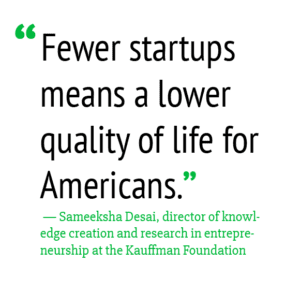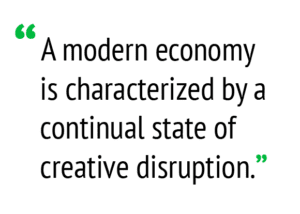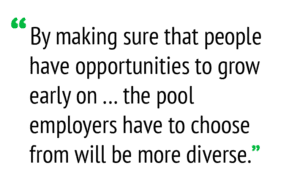Entrepreneurs have always been an integral part of the world’s economy. Towns of yesteryear needed blacksmiths, bakers, cobblers and more to serve their communities and make a living for themselves. Today, e-commerce and online communication mean people can start global businesses with little overhead; self-starters with their own businesses and products range from street venders to Etsy store owners to the Mark Zuckerbergs of the world. Within this dramatic shift comes changes to how entrepreneurs start and maintain businesses that contribute to the global economy.
In the following feature package about entrepreneurship, Talent Economy editors delve into entrepreneurial qualities, the economic value of entrepreneurship, demographics of these leaders and those starting businesses outside of technology.
Part I. What It Takes to Be Entrepreneurial
There are many skills and qualities required of successful entrepreneurs, including ability to network, work as a team, be creative and much more.
By Lauren Dixon
Working at Entrepreneur magazine for about five years, Linda Lacina met a lot of entrepreneurs. As managing editor of entrepreneur.com, the New York City-based publication’s website, she learned that while successful entrepreneurs all need to start with a great idea, product or service to get the company started the skills that led them to create the company won’t sustain them forever.
“For an entrepreneur to really succeed, they have to abandon the skills that got them started,” Lacina said. They need business acumen, marketing skills and resilience, to name a few.
And although it’s difficult to learn to read financial statements, to market successfully and to grow their business, they can seek advice from others by building their networks. People are more helpful than one would expect, she said. Building a network will help with those hard skills, creating communities of support, as well as coming to creative solutions through products, thus making the company better, faster and stronger, she said.
Nuanced Networking
Entrepreneurs shouldn’t limit themselves to familiar or similar networks, though; speaking to people internationally is also important, said Arvind Malhotra, H. Allen Andrew professor of entrepreneurial education and professor of strategy and entrepreneurship at University of North Carolina at Chapel Hill’s Kenan-Flagler Business School.
He often has his students meet entrepreneurs across the globe through LinkedIn in order to connect and ask questions. “Modern technology does afford you the ability to network,” he said. However, it doesn’t compensate for the fact that entrepreneurs still need to attend trade shows and demo days and hackathons. “The opportunity is there; you have to just get on the ground and devote time to that.”
Because different cultures have different communication styles and norms, successfully conversing with people across cultures requires patience, respect and reducing the ego to the level of apprentice in order to learn from another person, Malhotra said.
“Keen appreciation for global consideration is key,” he said. But while it’s important to be curious about global cultures, markets, ways of doing business and the regulations present in other countries, no one person can have an appreciation for all of those things. Instead, they must be open to engaging with others who can add to the entrepreneur’s knowledge. In other words: networking.
Teaching Teamwork
Teaching people to be entrepreneurs involves educating them to be disciplined in creating a company, and part of that is teamwork, said Erdin Beshimov, co-founder of MIT Global Entrepreneurship Bootcamp and lecturer at MIT.
“Entrepreneurship is a team sport,” he said. While there are instances in which entrepreneurs will work alone, they ultimately will need to have a team to make the company come to life.
 As the company grows, the leader must reinvent themselves, shifting responsibilities to others and paying attention to different aspects of the business, requiring more teamwork. It’s quite different to operate as a one-person startup than a 1,000-person company with multiple locations, Beshimov said.
As the company grows, the leader must reinvent themselves, shifting responsibilities to others and paying attention to different aspects of the business, requiring more teamwork. It’s quite different to operate as a one-person startup than a 1,000-person company with multiple locations, Beshimov said.
Some entrepreneurs will ultimately want to work alone and others simply want to stay at early stage companies. It’s fun to be in the period of quintessential formation early in the process, where there’s room for boundless creativity, Beshimov said.
Creating Creativity
While it is common to associate entrepreneurship with problem solving, it’s really more about the ability to find problems, Beshimov said. Entrepreneurs must be able to look for inconsistencies and contradictions in society that create frustrations for people; this often leads to an idea for a new product or service.
Creativity requires getting away from the daily grind of work, said Barry Kaplan, partner and executive coach for entrepreneurs at Shift 180 LLC, an executive coaching firm based in New York City. He also co-wrote “The Power of Vulnerability: How to Create a Team of Leaders by Shifting INward” with business partner Jeffrey Manchester. Kaplan suggested taking a weekend or a day off to draw, build with blocks and ideate without distractions.
Whether or not creativity can be taught is another story, though, but Kaplan thinks there are ways to teach anyone. “Some entrepreneurs don’t really belong in the traditional classroom, but they certainly can learn,” he said. Modalities for teaching might simply need adjustments for different people, such as getting away from the classroom or learning in a more hands-on approach.
Early Entrepreneurs
Many of the aforementioned qualities and skills of entrepreneurs are the same today as they were for people operating small businesses in the past, said Nathalie Duval-Couetil, associate professor and director of the Certificate in Entrepreneurship and Innovation Program and associate director for Burton D. Morgan Center for Entrepreneurship at Purdue University. However, the world is now more globally connected than ever, creating more competition.
Entrepreneurial ventures can last longer than businesses of the past by having public relations and flashy graphics that get attention, she said. However, “distilling what’s robust within all of that noise is more challenging,” Duval-Couetil said. Entrepreneurs can create beautiful websites, but the value there is questionable. Rising above that noise requires more communication than what early entrepreneurs used; today’s leaders must reach a variety of people, from customers to internal talent to shareholders. Successful communication is about knowing your audience and what’s important to them, Duval-Couetil said.
Finally, entrepreneurs need perseverance. “Entrepreneurs are hitting obstacles all the time, but they figure out how to redirect. They can overcome hurdles and come up with solutions in the process, as well,” Duval-Couetil said. As with other soft skills, this is difficult to teach, and to some degree this is an internal drive that people innately have. However, she said that conversations and first-hand accounts from people who have succeeded or faced adversity in the past can help students understand what is necessary to persevere in the face of overwhelming odds. “As much as we are trying to create entrepreneurs, it’s difficult to have a recipe to do so,” she said.
Part II. The Economic Value of Entrepreneurship
While startup growth remains significantly lower than in the 1980s, it has been improving in the past few years. Analysts say government, public policy and technology will play an important role in the future of entrepreneurship.
By Ave Rio
Ludwig von Mises, a famous Austrian-American economist, called entrepreneurship the “driving force of the market.” Today, it’s well-agreed upon that entrepreneurism has an enormous impact on the economy. Often seen as part of the American dream, entrepreneurship creates businesses and jobs and increases market competition.
When defined as innovation and initiative, entrepreneurship is essentially the only driver of economic progress, said Peter Klein, professor of entrepreneurship at Baylor University and author of “The Capitalist and the Entrepreneur.” “If we mean starting new things and bearing risks, all aspects of business and economic performance involve entrepreneurship,” he said. “Entrepreneurs are the agents who are responsible for bringing into existence, transforming and maintaining all the goods and services that we consume in an economy.”
In the narrower sense, Klein said it’s also true that small, young, high-growth firms often play a disproportionate role in the economy because they are “shaking up the establishment” and may be particularly innovative. “In both senses, you can’t have a successful society or a successful economy without entrepreneurship,” he said.
Entrepreneurship and Economics
New and young companies are the largest net job creators in the country, said Sameeksha Desai, the director of knowledge creation and research in entrepreneurship at the Ewing Marion Kauffman Foundation. “They are crucial not just to productivity and growth, but also to regional performance and to the long-term economic success of regions,” she said. “Fewer startups means a lower quality of life for Americans.”
In comparison, companies that have been around between six to 25 years have either neutral or negative job creation, and older companies, although dynamic, have increasingly been losing jobs in recent years, Desai said.
According to the Ewing Marion Kauffman Foundation’s 2017 “Growth Entrepreneurship” index, new companies create about 3 million new jobs per year. In data from the Foundation’s 2017 “Startup Activity” index, entrepreneurship has been in a long-term decline since the Great Recession but has been improving in recent years. In 2013, startup activity reached its lowest point in the past 20 years, but since then it has improved and almost reached the peak seen before the Great Recession drop.
 Startups are growing faster in their first five years than they did in the past, but overall, the rate of startup growth has been decreasing since 2003 and remains about 15 percent lower than in the 1980s, the report stated. Desai said it’s “the gazillion dollar question” as to why the recent recovery is strong, but entrepreneurial dynamism remains in a decades-long decline.
Startups are growing faster in their first five years than they did in the past, but overall, the rate of startup growth has been decreasing since 2003 and remains about 15 percent lower than in the 1980s, the report stated. Desai said it’s “the gazillion dollar question” as to why the recent recovery is strong, but entrepreneurial dynamism remains in a decades-long decline.
While companies seem to be less able to achieve some highly successful outcomes today than they were in the 1980s, that doesn’t mean the impact of successful entrepreneurship on the economy has shifted through time, said Jorge Guzman, research affiliate at the MIT Lab for Innovation Science and Policy and a post-doctoral entrepreneurship fellow at the National Bureau of Economic Research.
His research shows that while entrepreneurship is seen as a foundation for economic growth, only a small amount of all startups “realize the extraordinary level of growth that can propel economywide dynamism.” He said entrepreneurial quality is correlated with economic growth but entrepreneurial quantity is not.
When looking at entrepreneurship in a historical context, it’s not that the amount of entrepreneurship and its quality has changed, but rather, Guzman said entrepreneurship’s relationship to economic growth has changed. “There seems to be a cyclical response between entrepreneurship and economic growth,” he said. “When there’s economic growth, entrepreneurship seems to be also increasing, perhaps because of growth in opportunities for entrepreneurs to pursue, or other reasons.”
Entrepreneurship and Policy
Guzman said government and public policy play an important role in entrepreneurship on many levels. “There’s a lot of research that government supports through the National Science Foundation and the National Institute of Health from which the great entrepreneurial ideas come from.”
He said government also plays a role in providing the right tax structure to support entrepreneurs. Along those lines, the Kauffman Foundation’s new “Zero Barriers” initiative works to collaborate with entrepreneurs and policymakers to identify barriers against entrepreneurship — tax codes and otherwise — and develop solutions. “We see that entrepreneurship is experiencing a resurgence,” Desai said. “But it’s still about half of where it has been and we really want to break away some of the barriers to let it flow.”
Baylor University’s Klein said entrepreneurs want stable and predictable rules. “They want a legal system that enforces private property, that protects people against certain kinds of harm, that enforces contracts and can solve problems in a court system,” he said. “They don’t want to be told specifically what to do. They don’t want the government subsidizing particular companies.”
Klein pointed to the emphasis on green energy and giving cash subsidies to companies making solar panels during the Obama administration. “While most entrepreneurs and economists would probably say solar panel technology is better than burning coal, if that’s the case then the market can figure that out on its own,” Klein said. “If the only reason you’re making them is because of a government subsidy, that can pose a lot of problems because those entrepreneurs are not trying to satisfy consumers on the market; they are trying to chase the subsidies.”
But MIT’s Guzman argued that it makes sense to subsidize when there are spillovers: benefits of production that are not fully reflected in market demand or supply schedules. For example, he said that for every manufacturing job, 1.6 service jobs are also created. However, that number isn’t known for entrepreneurship.
“For every startup job, how many other jobs in the economy are created?” Guzman said. “If you think that’s higher than zero, it would make sense to invest in creating those startup jobs because it would create some broader economic benefits.”
Entrepreneurship Into the Future
The increasing pace of technological change has also impacted entrepreneurship. Klein said intangible assets like knowledge are seemingly more important as a source of competitive advantage and economic growth today than 50 to 100 years ago.
 “Highly innovative and highly entrepreneurial companies seem to be — at least on the surface — more important than they were before,” Klein said. “On the other hand, it’s hard to measure the quantitative amount of knowledge, or the impact of knowledge now versus some other time.”
“Highly innovative and highly entrepreneurial companies seem to be — at least on the surface — more important than they were before,” Klein said. “On the other hand, it’s hard to measure the quantitative amount of knowledge, or the impact of knowledge now versus some other time.”
The kinds of companies that have risen in the past couple of decades, such as Apple, Google and Amazon, will continue to grow and be more influential than manufacturing companies in the future, Klein said. But a modern economy is characterized by a continual state of creative disruption — new companies and products displacing old companies and products — and that will continue in the foreseeable future.
“Twenty years from now, the dominant technology firms may not be the ones we’re used to; they may be ones we’ve never heard of,” Klein said. “A dynamic economy characterized by disruption is good for the consumer, but it can place a lot of stress on employees and business owners because nothing is certain. There’s always the chance a new competitor will come along and knock you out of place.”
Part III. The Slow Rise of Diversity in Entrepreneurship
As the American population becomes increasingly diverse, entrepreneurship isn’t seeing the same shift. But more people are pushing for this change, and more trends are allowing it.
By Andie Burjek
While entrepreneurs and innovators have an important role in the U.S. economy, some groups of people tend to be more represented than others in the community. Between 1970 and 2010, the U.S. minority population increased from 16.5 percent of the total population to 36.3 percent, with the Hispanic population booming from 4.5 percent to 16.3 percent and the African-American population slowly growing from 11.7 percent to 12.6 percent, according to the U.S. Census Bureau. Still, entrepreneurial ventures remain dominated by white men, reports the Ewing Marion Kauffman Foundation.
As the U.S. population diversifies, that fundamental change is not represented in the entrepreneur population — yet.
“The demographics are shifting, and that creates interesting opportunities in research for us to understand what’s happening with the population of the U.S.,” said Regan Stevenson, professor of entrepreneurship at the Kelley School of Business at Indiana University, whose research focuses on entrepreneur psychology and the growth challenges entrepreneurs have in the early stages of development. His career began as an entrepreneur in the health food industry, and his experience has given him both a personal and academic point of view on entrepreneurship. “As the population changes, so does entrepreneurship essentially.”
We must consider what’s keeping the entrepreneurship community so white, male and urban. Some people say that this can be explained by the lack of women or minorities in the talent pipeline. While there’s some truth to this, there’s much more to the story.
The Forces Impacting Demographics in Entrepreneurship
When entrepreneurs hire their first employees, talent is front of mind. “What you’re looking for is for people who can offset the weaknesses you have as an individual entrepreneur,” Stevenson said.
“When I look at building my team, the only diversity I really focus on is skill sets,” said Tim Heyen, founder of Gearhead Workspace, a Chicago-based DIY garage and community for automotive enthusiasts. He founded Gearhead two years ago and his company currently has four employees. “I have a tiny team. I don’t want too much overlap on people on their skill sets. When you’re working with four people, skillset trumps everything.”
The growth phase can be a valuable time to more purposefully consider diversity, he added. Since the business is exposing itself to a broader audience, it helps to have a different point of view on the team.
This brings up the question of whether enough women or minorities are acquiring the necessary skills to then join those growth-phase teams.
When asked what the primary cause is for underrepresentation of women and minorities in tech startups, 41.6 percent of founders said there aren’t enough women and minorities going into tech in the first place, according to the “State of Startups 2017” survey conducted by venture capitalist firm First Round. It surveyed 869 venture-backed tech startup founders. Few founders cited lack of industry mentors or role models (10.6 percent), industry culture (1.1 percent) or venture capitalists (0.9 percent).
There are certain flaws to looking at the pipeline this simplistically, though. For one, most girls interested in the STEM field are not encouraged to go into STEM careers, according to Julie Kantor, founder, president and CEO of Twomentor, a training and leadership development company based in Bethesda, Maryland. This is her fifth startup, and she launched the company two years ago.
One also has to consider the reasons women do drop out of STEM jobs, she added.
“I don’t think you can just say there’s not enough of a pipeline,” Kantor said. “There’s [two] sides to it. One, you have to recruit broader. Two, if 50 percent are dropping out, you have a retention problem. I agree there’s a pipeline problem, but there’s also a retention problem.”
This retention problem is especially relevant in the tech startup space because those jobs pay on average 30 to 40 percent more, Kantor said. Also, that space is where many newly created jobs are, for example in computer science and engineering.
Harassment is one major reason women leave jobs in this industry. According to First Round’s report, 78 percent of female founders report say they have been sexually harassed or know someone who has been. Meanwhile, 22 percent of male founders said the media has overblown the issue.
“People feel like they have to leave their careers, not because they don’t love their job, but because they’re in a hostile environment and they can’t take it anymore,” Kantor said.
Making More Room for Diversity at Startups
Funding is another key factor that allows entrepreneurs to get their businesses going. “In the last 15 or 20 years we’ve seen that in the venture capitalist world there has been a large underrepresentation of women being funded,” said Indiana University’s Stevenson.
Despite these trends, crowdfunding has had a big impact on entrepreneurship, he said. People who need to raise money to start a company don’t have to rely on a bank anymore; they can rely on their peers. “Crowdfunding through Kickstarter, Indiegogo and many other platforms has really opened up the door for a lot of people who might not have been otherwise able to raise any capital at all in previous generations,” he said. “I think this is a trend that is helping a lot of people who have been disadvantaged in previous generations find a way in.”
The Fix Crowdfunding Act, commonly referred to as Regulation Crowdfunding, has also made it easier for entrepreneurs to go this route. The 2016 federal legislation allows entrepreneurs to raise capital from nonprofessional investors throughout the country. Although fundraising through nonprofessional investors existed before 2016, it was very burdensome, Stevenson said. Regulation Crowdfunding removed many restrictions. For example, previously entrepreneurs could raise capital, but they’d be restricted by state in which they operate. That limited people to specific areas, which ultimately capped the amount of money that could be raised.
Sponsorship and mentorship are other ways to increase diversity. Ali Shaw, executive editor at Portland, Oregon-based Indigo Editing and Publications, founded her company 12 years ago and currently has a team of eight people. She takes it upon herself to coach and help them hone their skills.
“I work with them in starting their own businesses, too, if they haven’t already, so that they can consistently be getting work outside of Indigo to supplement as needed. I want them to have those skills to be able to take care of themselves,” said Shaw.
The publishing industry’s workforce is mostly female, but a majority of business owners are men, said Shaw. She participates in a Women in Portland Publishing networking group to connect with other women in the industry.
“Because I help [my team] set up their own businesses, I feel like that’s sort of helping to combat these stats in the publishing industry,” she said.
Kantor agrees that mentorship has a lot of power to move people forward in their careers, and it’s the concept on which she founded TwoMentor. However, while a mentor offers guidance and support to people to achieve their career goals, a sponsor is someone higher-up who has an influential role in the company.
Silicon Valley, in the tech start up space, is built on sponsorship, she said. To elevate women in the STEM jobs, “it’ll be critical that we not only build sponsorship relationships, but that we become sponsors ourselves and that we have power, influence and networks and learn how to better flex those muscles,” she said.
Looking Forward
Although women and minorities are underrepresented in the entrepreneurship community in general, they are gaining more ground. Women small-business owners are one of the fastest growing segments of the nation’s economy, according to a poll conducted by the advocacy group Small Business Majority.
Education plays a role. Kantor once ran an organization that taught entrepreneurship to kids from low-income communities. She recalled “seeing their eyes light up when they learned that they could start their own small businesses.” They hadn’t believed the opportunity was there for them.
A startup needs to hire skilled individuals, so ensuring that people in marginalized communities have access to educational programs is a great place to start, said Shaw. By making sure that people have opportunities to grow early on — whether that’s during grade school, grad school or an internship — the pool employers have to choose from will be more diverse.
“It’s slow. It’s baby steps. But I hope that it continues to improve,” she said.
The entrepreneurship boom is relatively recent, said Gearhead’s Heyen. Whereas 10 or 15 years ago, people went to business school to become a CEO or investment banker, now entrepreneurship is an interest that has grown. “I think that fact that many universities are upping the amount of resources they put toward entrepreneurship, I think we’ll see that help moving forward,” he said.
Currently, especially if you look at Silicon Valley startups, many of the people who run those startups are the ones born with extra advantages, Heyen said. But he sees certain forces challenging that. For example, there’s much more visibility now toward diversity and movements aimed at empowering people, and now more a more diverse group of educated people are demanding a seat at the table.
“But it does seem like there are a lot of forces coming into play now that are going to help push that along,” Heyen said. “I do think there’s reason to believe that will get better, but it is definitely going to be something that people will have to actively push for. It’s not going to happen overnight.”
Part IV. Real-World Entrepreneurs
Non-tech startups face a long road, but a lot of networking and a little luck can help them build their brand.
By Sarah Fister Gale
When Xero Shoes, a small footwear company in Boulder, Colorado, hit $5 million in annual revenues, its founder Steven Sashen thought he’d have no problem securing capital to grow the business.
He was wrong. “I have tech startup friends who received eight-figure valuations for their companies before they even had a product,” Sashen said. “We are a profitable business with real customers, but it is still challenging to find financing.” It is a common problem for non-tech entrepreneurs whose products may be less flashy than tech startups and require significant capital to produce and sell.
Part of the appeal of tech companies is the speed to market and access to intellectual property, says Cleveland Justis, executive director at the Institute for Innovation and Entrepreneurship at University of California at Davis. “Successful tech firms can achieve scale and make money quickly,” Justis said, whereas traditional product and service-based companies can take years to gain a market foothold, and they are capital intensive. “There is a lot less funding available for these companies.”
 Beyond the ability to secure money, however, tech and non-tech startup companies face a lot of the same challenges. It starts with diverse leadership. “All research suggests that the more diverse a company’s skill sets are, the more likely they are to succeed,” Justis said. Whether you are building an app or designing shoes, having people with finance, business and marketing skills to complement the core product creation will reduce risks and gaps on the team.
Beyond the ability to secure money, however, tech and non-tech startup companies face a lot of the same challenges. It starts with diverse leadership. “All research suggests that the more diverse a company’s skill sets are, the more likely they are to succeed,” Justis said. Whether you are building an app or designing shoes, having people with finance, business and marketing skills to complement the core product creation will reduce risks and gaps on the team.
Non-tech entrepreneurs also need good advisers, a strong network and a clear understanding of why people will buy their product. “A lot of entrepreneurs start with a solution then go looking for a problem that it can solve,” Justis said. That can cause them to spend a lot of time and money building something no one wants.
To avoid that risk, Justis spends much of his time helping entrepreneurs figure out first whether their idea is something people will pay for and who that customer might be. If they pass that litmus test, he encourages them to create a pitch deck and start sharing it with everyone they know. “You need to get comfortable talking about your idea so you can get feedback,” he said.
Growing Bean Sprouts
Shannon Seip, co-founder of Bean Sprouts Café, a healthy kid-focused café found in museums, zoos and other family venues across the country, relied on her ability to tell the Bean Sprouts story to make her business a reality. She and her partner started Bean Sprouts in 2007 in Madison, Wisconsin, as a fun place for kids to eat, with child-height displays and a healthy menu. They started the first restaurant with their own funds and a few loans from friends and family. “When that ran out we did a ton of networking,” she said. They reached out to women’s investment firms, restaurant organizations, healthy eating blogs and anyone else they thought might help.
The growing interest in child-focused health food at the time not only helped attract customers; it also gained them support from industry experts to fill gaps on their team. Seip recalls reaching out to former Food Network star and cookbook author Gale Gand, who she met through her own network, for advice on building the original menu. Seip was just happy to get her on the phone, but Gand, who had twin toddlers at the time, loved the idea so much she agreed to create a menu for free. “It was a great lesson about the importance of asking for help,” Seip said. Gand’s work on the menu would have cost her $40,000 but she did it for free because she supported the idea. She has continued to mentor Seip and provide feedback on new menus. All of that networking helped the company grow from a corner store in Wisconsin to a national chain will 12 locations in six states and 10 more in the works.
On the Right Foot
Xero’s Sashen saw similar success by talking to anyone who would listen about his vision to “reinvent the shoe.” In 2009, the competitive sprinter created a minimalist running sandal out of rubber and cord to simulate barefoot running while protecting his feet from cuts. People started asking where they could get them, and then an author of a barefoot running book offered to mention the shoes. The rest is history. “We thought it would be a hobby,” he said. “But three months later it was our full-time job.”
From the start, Sashen had no problem sharing the secret to his footwear. On the day they started the business, he made a YouTube video showing people how they could make their own sandals. “Some people thought I was giving the whole company away,” he said. Instead, the video garnered more than a million views and helped build word of mouth about the brand.
Sashen never stopped telling people his story, and that enthusiasm continued to win him the help he needed to build the brand. Early on two former designers from Nike and Reebok learned about his ideas and offered to help him build his business plan and design some of his products. In 2012 at the local dog park, he met a retired developer of Crocs, who he convinced to join the company as the new chief development officer. And while visiting China he found a bar called Irene’s frequented by many shoe industry professionals. Irene’s husband mentioned that he was retiring because his company was moving to Indonesia. Over drinks, Sashen’s chief product officer, offered him a job, which he agreed to. “He’s been instrumental in helping us improve our products and their manufacture ever since,” Sashen said.
Sashen also asks every customer for feedback and uses that to adapt current and future products.
Despite Xero’s success — the company has achieved 80 percent revenue growth per year for the past four years and now offers a line of hiking and running shoes — he still struggles to win over investors. The capital-intensive company requires annual financing to produce its products, but bankers would only give him money based on the previous year’s earnings rather than future projections. That means Xero was running out of inventory every year, though his word-of-mouth approach to business eventually helped him overcome this obstacle as well.
Last year Xero was one of the first companies to launch an equity crowdfunding project, in which new regulations allow startups to sell equity stock to a broad range of investors. Sashen’s team spread the word about the crowdfunding to their core customers and ultimately secured $1 million from 1,100 investors — half of whom had never bought a product. “It’s a really cool example of the power of word of mouth,” he said.
Both Bean Sprouts and Xero Shoes are proof that relentless networking is one of the best ways for a startup to fill their talent gaps, find investors and dazzle customers. It can be scary to ask for help,” Seip said. “But it is the only way you are going to get off the ground.”
It also helps to have at least a little bit of luck, Sashen added. “Starting a business takes a ton of hard work, but in the end, luck was the factor that put us through the roof.”
Lauren Dixon is senior editor at Talent Economy. Andie Burjek and Ave Rio are associate editors at the publication. Sarah Fister Gale is a writer in the Chicago area. Jackie Ferrentino is an illustrator in Brooklyn, New York. To comment, email editor@talenteconomy.io.


















